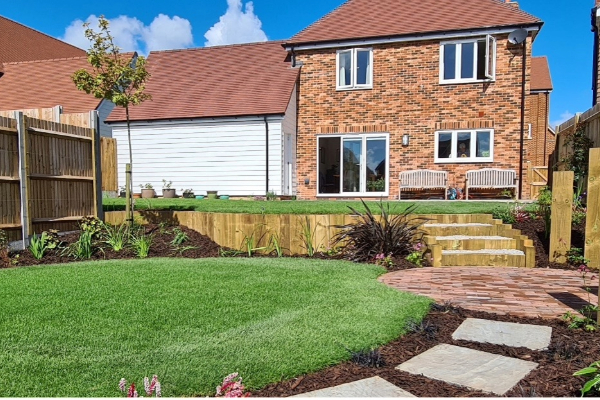
Garden Drainage Solutions for New Homes
07 March 2024
Weather patterns are becoming increasingly more extreme, causing excessively damp conditions in our gardens and posing a particular problem for new-build homes.
Discover How to Improve Garden Drainage with Practical Solutions:
Identify the Cause of Poor Garden Drainage
A number of factors can cause water-logging of your garden. In a new home garden, there are two common causes, soil compaction and shallow topsoil over clay subsoil, sometimes both together. Here are some solutions.
Perform a Soil Assessment
Dig a test pit. A hole 45cm x45cmx45cm is usually plenty to see what’s underground. Leave a clean vertical side to the pit and you should be able to see the soil ’profile’. In this context the first two profiles are of most interest. These are the topsoil and the subsoil.
Understanding Topsoil Quality
This supports the growth of your shrubs or lawn. It may be soil that has been removed prior to the build and then re-spread, or an imported ‘blended loam’- a mixture of crumbs of clay, coarse sand and organic matter.
The topsoil should be at least 15cm thick for satisfactory lawn growth, 30cm for shrubs and ideally deeper still for trees. If less, plant growth may be adversely affected.
Evaluating Subsoil for Drainage Issues
This will typically have very little organic matter and depending on your locality could be formed mostly of clay, chalk or sand. Poor drainage is usually associated with clay subsoils. To identify the subsoil, you should see a clear change in colour, texture or composition where the topsoil meets the subsoil layer.
Soil Condition and Water Retention
Now assess the soil. Commonly the topsoil will be saturated because the subsoil is not absorbing any water. This may be due to the physical nature of the subsoil (heavy clay is simply not free draining), compaction due to heavy site traffic during the build, or both.

A test pit will reveal the soil profile and condition
Other Garden Drainage Problems to Watch For
Beyond soil issues, consider these potential causes:
-
Low-lying gardens acting as sumps
-
High water tables
-
Broken pipes
-
Runoff from neighbouring paving
These aren't unique to new builds but may worsen existing drainage problems.
DIY Garden Drainage Solutions You Can Try
Fixing Soil Compaction
Compaction can be relieved by cultivating the soil. If the compaction is within the subsoil, then the topsoil needs to be removed first and then replaced.
Heavy Clay Impeding Drainage
The clay must either be removed or improved. This means either replacement with good topsoil or mixing-in coarse sand, grit and organic matter.
Solving Shallow Topsoil Issues
To support plant growth more soil should be added. This may mean removing subsoil first to retain current ground levels or building up the soil level over the subsoil. In doing this, a greater depth of permeable soil is also created with the effect that rainwater can be dispersed even if the subsoil is not free draining.
Speak with Your Builder About Persistent Drainage
Sadly, gardens are rarely a high priority for house builders, but it is likely they will be well aware of any drainage problems. To tackle them across the whole site would significantly add to their costs but if pushed they may take action to help resolve your particular problem.

A waterlogged garden in need of a drainage solution
Permanent Garden Drainage Solutions to Consider
Installing a Land Drainage System
If the causes of the bad drainage can’t be fully remedied, it may be possible to remove the water from the soil. This could involve gravel filled trenches at strategic positions (known as ‘french drains’), or even a full piped land drain system. To be effective, the water must be able to reach the chosen drain so attention must be given to siting, spacing and depth of the drains, as well as improving the soil condition. Then the water must have somewhere to go. For land drainage an adjacent ditch is ideal or if you have a large garden, a lower lying area which you don’t mind becoming a seasonal pond or ‘swale’, may suffice.
Drainage for Hard Surfaces
Non-porous hard surfaces are always laid to a fall, so water runs-off. This can add to an existing drainage problem. In this case, pot gully drains can be set within the area or slot (‘acco’) drains along the low edge. Subject to site specific planning rules it may be possible to then pipe it to your storm drains (but not the main or foul drains), otherwise it must discharge to a soak-way. This is a hole in the ground filled with hardcore or better, plastic drainage crates. To be most effective it must be sited in ground that drains reasonably well otherwise it will quickly fill and be of less benefit. Addition of an overflow pipe may help, as long as there is somewhere to discharge the excess water to.

Raised Beds allow plants that are intolerant of wet soil to thrive
How to Improve Garden Drainage with Design
Creative Solutions
It is sometimes better to go with, rather than to fight nature. Stepping stone slabs laid through a lawn that is wet in winter will provide a firm dry pathway.
For happy plants, adopt the ‘right plant, right place’ principle. Some plants hate wet feet, others will tolerate some winter waterlogging.
If your favourite plants don’t like wet soil, plant them in raised beds or just gently mounded borders to lift roots out of wet ground.
Wet Garden Ideas
With an understanding of the causes and appropriate solutions your problem garden can be transformed into something beautiful. The image below shows a garden design solution for the waterlogged garden pictured above. Because the garden is situated in an area with no means to effectively drain it, we took a ‘go with the flow’ approach and got creative. It now features an elevated boardwalk over a ‘dry’ steam bed which becomes real in winter and has an added pump system backup. You can read the full case study here.

Creative garden design solution for the waterlogged garden shown above
Ready to Transform Your Garden?
At Haywood Landscapes, we have been advising clients and building beautiful gardens across Kent and the surrounding areas for over 30 years.
If you’re ready to see what our creative garden designers can do with your new-build outdoor space, get in touch with us or call 01227 733447 today.





